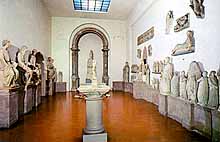
The Museum of the Opera del Duomo
The Museum is situated on the north eastern side of the square (at
number 8), in a building that was created especially for the Opera del Duomo,
or rather, the large number of administrators, artists and craftsmen (stone
cutters, marble workers, carpenters...) who were employed in the construction
of the new cathedral of Santa Maria del Fiore, which was commissioned in
1296. The Wool Guild, from whom the Opera
took its coat of arms with the Agnus Dei, supervised the entire organization
(from 1331 to 1770). Some of the crushing costs of the basilica were covered
by the sale of wood from the forests of the Casentino, which the government
of the Florentine Republic donated to the
Opera in the late 14th century.
The institution therefore needed plenty of space: apart from the actual building
site, it needed to be able to store all the huge uncut blocks of marble, as well
as all the stacks of wood for sale. The palace we can see today was built over
an earlier farmhouse and its land, purchased in 1400, which backed on to Lorenzo
Ghiberti's workshop and furnaces (where the artist cast his bronze doors
for the Baptistery). Donatello's workshop also stood in the vicinity, on
the corner of Via Ricasoli. Filippo Brunelleschi was
assigned the site for the new palace in 1432 but only the courtyard of this building,
situated in front of the Museum entrance and subsequently altered several times,
can still be seen today.

Brunelleschi, models for the Cupola
Once the basilica was completed, the Opera stayed open for the care and
maintenance of the holy group of buildings, composed of the Duomo,
the Baptistery and the Belltower and,
after 1891, also opened some of its rooms to the public, transforming them
into a Museum (architect Luigi Del Moro).
In fact a great many masterpieces from the three monuments, together with various
historic reminders connected with the actual construction of Santa Maria del
Fiore, like Brunelleschi's model for the cupola, the numerous
16th-17th century projects for the facade and pieces of
building equipment (winches, trolleys, ropes...), had gradually been collected
here over the centuries.

Equipment used for the
construction of the Cathedral
The first art works to be brought to the seat of the Opera were pieces
of sculpture from the north door of the Cathedral (known as the Door
of the Mandorla), among them an Annunciation created by Jacopo della
Quercia for the lunette, replaced in 1491 with a mosaic by Ghirlandaio of
the same subject. These were followed by the sculptures created by Arnolfo
di Cambio, Nanni di Banco and Donatello (among others) for the first facade
of Santa Maria del Fiore, which was left unfinished and "dismantled" in
1587 at the orders of Grand Duke Francesco I de' Medici.
The statues of Pope Boniface VIII and the Madonna and Child (1296) by Arnolfo
are particularly beautiful, while the St. John the Evangelist was one of Donatello's
first masterpieces (1408-15).
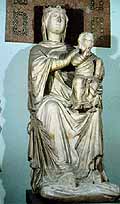
Arnolfo
di Cambio,
Madonna and Child
The beautiful Choir Lofts by Donatello (1433-38) and Luca
della Robbia (1431-35), carried out as headpieces for the two sacristies
in the Cathedral and dismantled in 1688 for the wedding of the Grand
Prince Ferdinando with Violante of Baveria, were brought to the Opera
even later: this was when people suddenly began to realise that care
must be taken not to lose such valuable artifacts as these elsewhere.
They were followed by the sculptures carried out by Baccio Bandinelli from 1547-72
to close off the Cathedral Chancel and "disassembled"
in 1842.
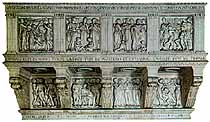
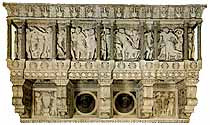
The Choir Lofts by Luca della Robbia and Donatello
In this century, apart from the two Roman sarcophagi that stood on either
side of the South Door of the Baptistery until 1971, the Museum has given
shelter to the various masterpieces that have been restored over the
years: these include the: Magdalen in wood by Donatello (from
the Baptistery), sixteen statues by Donatello (note
the Prophet Abacuc), Andrea Pisano and Nanni di Bartolo (from the Belltower),
the bas-reliefs in marble by Giotto (?), Andrea Pisano, Alberto Arnoldi
and Luca della Robbia (from the Belltower)
and even the panels for the Door of Paradise by Ghiberti. All these bas-reliefs,
statues and panels have today been replaced by copies.

Donatello,
the Prophet Abacuc
The priceless Altar of San Giovanni comes from the interior of the Baptistery:
composed of 400 kilos of silver, it was created between 1366 and 1480 by
artists like Michelozzo, Verrocchio, Antonio
del Pollaiolo and Bernardo Cennini.
A real monument to Florentine silversmithery, half Gothic and half Renaissance,
which was commissioned by the Guild of Merchants (or "Calimala")
and cost over 40.000 gold florins at the time (we should remember that Ghiberti
was paid 4.000 florins for the North Doors in the same period).

The silver Altar in S. Giovanni
The Pietà by Michelangelo comes
instead from the Cathedral (the Magdalen is by one of his pupils, Tiberio
Calcagni); the artist carried out this sculpture for his funerary chapel
in Santa Maria Maggiore in Rome between 1548-55 but left it unfinished because
of the poor quality of the marble, previously used for a capital in the
Temple of Peace.
He gave it to his friend, Francesco Bandini, and the statue was sold to the Medici
Grand Dukes by the Bandini heirs in the mid 17th century. It was at first placed
in the crypt in San Lorenzo then, after 1721, behind the high altar in the Cathedral
and lastly, from 1933, in the left transept, where it remained until 1980.
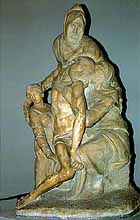
Michelangelo,
Pietà
As we can see, these are a series of masterpieces that provide a complete
panorama of the development of Florentine sculpture from the 14th to the
16th centuries. The Museum also contains a large number of Roman remains
which were reutilized in the construction of the two temples, sculptures
and bas-reliefs of all kinds and a huge collection of religious art (reliquaries,
crosses, caskets, chasubles, croziers...).
One room in particular is dedicated to a display of the 58 illuminated Choir
books that were in use in the cathedral until 1930: graduals, antiphonaries and
vesperals, carried out on parchment between 1508 and 1530 but unfortunately seriously
damaged in the flood of 1966.
